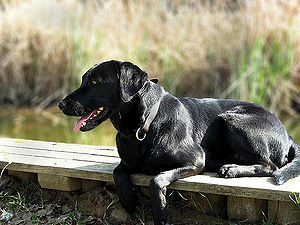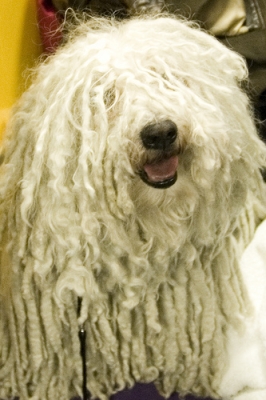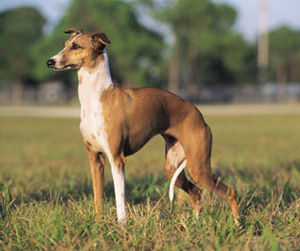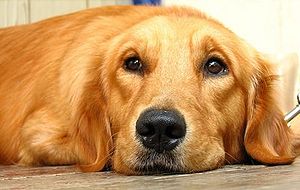 |
| Vital Statistics: |
| Place of Origin: Canada |
| Group: Sporting dog, Gun dog |
| Height: males 22-24 in., females 21-23 in. |
| Weight: males 65-80 lbs., females 55-70 lbs. |
| Life span: 10-13 yrs. |
| Trainability: high |
| Good with children: yes |
| Good with other pets: yes |
The Labrador Retriever is native to Newfoundland, Canada. English ships coming from Labrador in 1800 arrived in Great Britain bringing the Labrador Retriever. It has since become the most popular dog in the United States. English bred dogs are shorter and stockier while American breeds are taller and have a lighter build.
What does the Labrador Retriever look like?
The standard height is about 21-24 inches and weight is 55-80 lbs. The Lab has a thick nose and scissors bite with a broad head and powerful neck. Eyes are chestnut or hazel and ears are pendent. The tail is of medium length, covered with thick short hair and is known as an otter tail. The Lab’s coat is smooth, dense and oily and is water resistant. The colors are solid black, chocolate and yellow.
Note – Fox Red Labradors, as they are known, are not dtruly red. The color is actually a dark yellow and was the original color of Labs. It was the normal color until after World War II when lighter coat colors became much more popular. Today the fox red color is increasing in popularity.
What is the Labrador Retriever’s temperament?
This dog is a people dog, very intelligent, dependable, affectionate and playful. The Lab is especially good with children. Its high intelligence makes it easy to train. Daily exercise is very important. The Labrador can be a chow hound, so weight watching is a must. As with all dogs, the Lab needs daily exercise. If you have access to water, so much the better. The Lab is a loyal and loving family companion.
What are the Labrador Retriever’s uses?
The Labrador is a working dog of many talents including serving as a guide dog for the blind and as a service dog. It does well in obedience trials. The Lab has an excellent sense of smell and is a standout star retriever in water. It is also used by the police for its detection capabilities. The Lab is a wonderful companion dog.
Possible Health Issues
Hip/elbow dysplasia, progressive retinal atrophy, exercise-induced collapse, heart disease, osteochondrosis, panosteitis (growing pains), epilepsy, skin allergies.
- American Cocker Spaniel
- Boykin Spaniel
- Bracco Italiano
- Brittany Spaniel
- Chesapeake Bay Retriever
- Clumber Spaniel
- Curly-coated Retriever
- Dalmatian
- English Setter
- English Springer Spaniel
- German Shorthaired Pointer
- Gordon Setter
- Irish Red & White Setter
- Japanese Akita Inu
- Kai Ken Dog
- Karelian Bear Dog
- Lagotto Romagnolo
- Llewellyn Setter
- Mountain Cur
- Nova Scotia Duck Tolling Retriever
- Picardy Spaniel
- Pudelpointer
- Russian Spaniel
- Spinone Italiano
- Vizsla
- Weimaraner
- Welsh Springer Spaniel
- Welsh Terrier
- Wetterhoun
- Wirehaired Pointing Griffon
- Wirehaired Vizsla
- American Cocker Spaniel
- Barbet
- Boulet Griffon
- Boykin Spaniel
- Bull Terrier
- Clumber Spaniel
- Curly-coated Retriever
- Dalmatian
- English Cocker Spaniel
- English Setter
- English Springer Spaniel
- Flat-coated Retriever
- German Shorthaired Pointer
- Golden Retriever
- Gordon Setter
- Harrier
- Irish Setter
- Irish Water Spaniel
- Kishu Inu
- Kooiker Hound (Kooikerhondje)
- Lagotto Romagnolo
- Landseer
- Mountain Cur
- Nova Scotia Duck Tolling Retriever
- Otterhound
- Picardy Spaniel
- Poodle
- Pudelpointer
- Redbone Coonhound
- Redtick Coonhound
- Rhodesian Ridgeback
- Spinone Italiano
- Stabyhoun
- Sussex Spaniel
- Telomian
- Treeing Tennessee Brindle
- Vizsla
- Weimaraner
- Welsh Springer Spaniel
- Wirehaired Pointing Griffon
- Wirehaired Styrian Mountain Hound
- Wirehaired Vizsla



